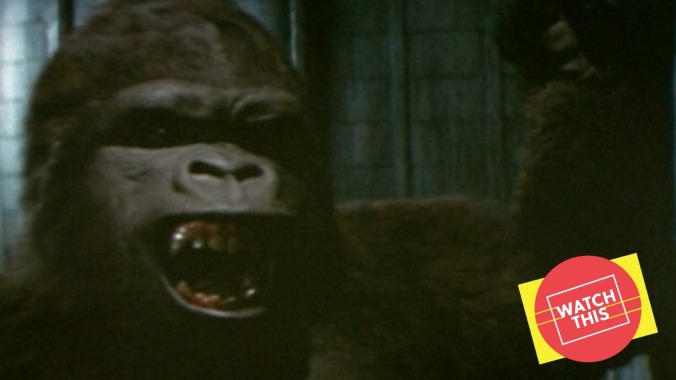The ’70s King Kong launched and damaged the career of a young Jessica Lange

Watch This offers movie recommendations inspired by new releases, premieres, current events, or occasionally just our own inscrutable whims. This week: In honor of his upcoming title fight against Godzilla, we’re looking back on the most significant starring vehicles for the Eighth Wonder Of The World, the giant ape to rule them all, King Kong.
King Kong (1976)
The original King Kong is an enduring fairy tale: a classic monster movie that’s retained a surprising amount of its primeval power and magic nearly a century later. There’s nothing so timeless about its first remake, the one that arrived in theaters on a wave of hype and publicity right before Christmas of 1976. Produced by Dino De Laurentiis and directed by John Guillermin (then fresh off mega-hit disaster movie The Towering Inferno), this King Kong is goofy and horny, with expensive but tacky effects that haven’t aged half as well as those found in its Golden Age ancestor. Yet that dated quality is actually what lends it a certain retroactive charm, the kind only time can confer. Now as far from 1976 as 1976 was from 1933, we can appreciate this one-time box office smash as a strange artifact of a lost world, its various flaws and quirks operating as windows into another era’s taste in popcorn entertainment.
Like its predecessor, the ’76 Kong begins on the precipice of an oceanic expedition. This time, however, it’s an oil executive, Fred Wilson (Charles Grodin), leading the charge to Skull Island, where he hopes to uncover untapped reservoirs of petroleum. It’s a bad idea, insists stowaway Jack Prescott (Jeff Bridges), the dashing paleontologist who regales the crew with stories of a roaring beast believed to reside where they’re headed. And sure enough, that’s what they find: the giant ape Kong, who’s worshipped as a god by the natives and emerges from the jungle outside their gated village to snatch up blushing blond Dwan (Jessica Lange), who Wilson, Prescott, and company find floating in a lifeboat en route to their foggy destination.
If that seems like a coincidental explanation for how an aspiring actress ends up aboard a tanker in the Indian Ocean, you have a sense of the various logistical problems created by making the Carl Denham figure a Big Oil guy instead of a filmmaker. The change was meant to thrust King Kong into a new age of energy crisis and corporate greed, but it mainly raised questions screenwriter Lorenzo Semple Jr. was forced to clumsily answer, like why Wilson would want to drag a giant, deadly primate all the way to New York City. (Do oil companies really need big publicity stunts to make money?) In another contemporizing touch, Kong ends up scaling the then-recently constructed World Trade Center instead of the Empire State Building. Other changes, like the decided dearth of fellow prehistoric monstrosities, were matters of budget.
The real difference is tonal. The ’33 King Kong was mythic and grand, as if pulled straight from legend. The ’76 version has a breezy tongue-in-cheek nonchalance. “Who the hell do you think went through here, some guy in an ape suit?” Bridges quips after Kong first nabs Dwan, undercutting one of the few sequences in the movie that inspires any real awe. As we’ve noted, there’s no actual romantic chemistry between Kong and his human captive in the original. The remake, with its sweeping John Barry theme and picturesque Hawaiian scenery, adds some—it plays like a vaguely kinky love triangle, with scenes of Kong sensually bathing his kidnapped prize, who lets him down easy with a cooed, “This thing’s just never gonna work.” King Kong was Lange’s first film role, and though it was a huge hit, she spent years trying to live it down. The career damage was unwarranted: She’s a bubbly delight, like Marilyn Monroe thrust into a big F/X movie, and does more than anyone to make the jokey, sympathetic, beauty-beast dynamic work.
If critics were too hard on Lange, they weren’t wrong to call King Kong inferior. Not that reviews hurt the film: It tripled its budget, scored three Oscar nominations, and ended up winning one for its state-of-the-art effects, which now look primitive but charmingly inventive—at least all those concerning Kong himself, who’s brought to life via a costume and an animatronic mask worn by effects wizard Rick Baker, and by a pair of giant mechanical ape hands. Great movies require no lens of exotic appreciation; the original King Kong is exciting, not “exciting for its time.” But when it comes to big studio movies, time does have a way of making even the follies look more interesting, if only through the novelty of sensibilities and techniques that have passed out of fashion. Once received by many as the epitome of bloated spectacle, the ’76 King Kong now appears fascinatingly unusual, and even small in the way it transforms a Hollywood myth into a cheeky tropical rom-com. Maybe there’s an optimism in this cycle of rediscovery and minor aesthetic redemption: Today’s obnoxious, overblown blockbusters are tomorrow’s time capsule curiosities.
Availability: The ’76 version of King Kong is currently streaming alongside the original on HBO Max. It can also be rented or purchased digitally from Amazon, Google Play, YouTube, Microsoft, Fandango Now, Redbox, DirecTV, and VUDU.